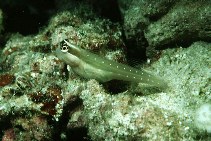| Family: |
Blenniidae (Combtooth blennies), subfamily: Salariinae |
| Max. size: |
7.5 cm TL (male/unsexed) |
| Environment: |
reef-associated; marine |
| Distribution: |
Western Pacific: Queensland from Cape York Peninsula at 12°S to the Bunker Group, southern Great Barrier Reef. |
| Diagnosis: |
Dorsal spines (total): 11-12; Dorsal soft rays (total): 14-16; Anal spines: 2-2; Anal soft rays: 16-18. Dorsal fin XI-XII (typically XII), 14-16 (typically 15). Anal fin II,16-18 (typically 17). Pectoral fin 12 or 13 (rarely 12). Segmented caudal-fin rays 13. Vertebrae 10 or 11 (rarely 11) + 21-24 (rarely 21, usually 23) = 31-34. Dentary incisor teeth which includes anterior canine teeth very similar in appearance from incisors, 45-53; posterior dentary canines (specimens at least 25 mm SL) 3-8 on each side (rarely 3). Lateral line lacking pairs of pores, terminating posteriorly at point between verticals from dorsal-fin spines 9 and 11 (rarely surpassing vertical from 9). With cirrus on posterior rim of anterior nostril; absent on anterior rim. |
| Biology: |
Adults are found on coastal reefs (Ref. 2334). Oviparous. Eggs are demersal and adhesive (Ref. 205), and are attached to the substrate via a filamentous, adhesive pad or pedestal (Ref. 94114). Larvae are planktonic, often found in shallow, coastal waters (Ref. 94114). |
| IUCN Red List Status: |
Least Concern (LC); Date assessed: 25 March 2009 Ref. (130435)
|
| Threat to humans: |
harmless |
Source and more info: www.fishbase.org. For personal, classroom, and other internal use only. Not for publication.

